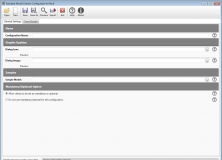


Use tool like TransMagic to stitch your surfaces into solids.Request the file in a different format.Attempt to get your design or engineering task done using only the surfaces.Use your native tools to try and stitch the surfaces into a solid model.If your geometry comes in as a collection of surfaces, you’ll be forced to either: Some CAD systems can stitch IGES surface files without gaps into a solid model, but not all CAD or other downstream tools can do that. A user may be able to resolve a good surface model into a solid using the CAD system’s modeling tools, but starting with a surface model ultimately ends up creating more work for the user.įigure 3 – Opening an IGES file in SOLIDWORKS.įigure 3 is made of two screenshots at left, how an imported IGES file with gaps appears in the feature tree, and at right, how an imported IGES file that is watertight appears in the feature tree. There is no ability to add features to this part, or perform feature recognition. The surface model with gaps is the image at the bottom of the figure note that it comes in as what Inventor describes as a “Composite”. The STEP import is the image on the top of the figure notice that the file imported as a “Base” feature, meaning you can now build further features on it (or use feature recognition on it). If you need the ability to edit features on the model (and that model was not built using your native CAD software), feature recognition can be employed to accurately assess and re-create part features – however, feature recognition tools need a watertight solid for input, and an IGES surface is not a watertight solid.įigure 2 shows the result of importing a IGES surface model without gaps into Inventor vs importing a STEP file. It’s far easier to edit a solid model by selecting a face and adding a sketch or a placed feature. Often it is desirable to make edits on an existing CAD model, but editing a surface is tricky business. IGES models, being surfaces, do not typically work well in CAD/CAM/CAE applications. IGES Geometry is not as ‘Information Rich’ as Solid Geometryįigure 2 – Opening an IGES file in Inventor. By comparison, the STEP standard was first released in 1994, and work continues on STEP to this day, just as it does with other useful neutral formats such as Parasolid, ACIS, SMS and JT. At this writing, that makes IGES 20 years old, an eternity in the CAD world. The last official version of the IGES standard was in 1996. Here, then, are six reasons to avoid IGES files: 1. In fact, the 2013 3D Collaboration and Interoperability Report published by Jackson and Prawel noted that IGES was the second most commonly exchanged neutral CAD format right behind STEP, with 58% of companies choosing that over 3D PDF, Parasolids, ACIS or JT.

IGES stands for Initial Graphics Exchange Specification it was first published in 1980 as a vendor-neutral file format to facilitate the transfer of information among different CAD systems, and though use has dropped in the last decade, IGES is still a widely used format in the manufacturing world. A follow-up article, Three Alternatives to IGES Files, will propose some alternative formats which are better equipped to handle most 3D design data needs. This article defines some of the problems with the IGES format. The IGES file has been the bane of the CAD/CAM/CAE world for years, yet it remains with us to this day.


 0 kommentar(er)
0 kommentar(er)
